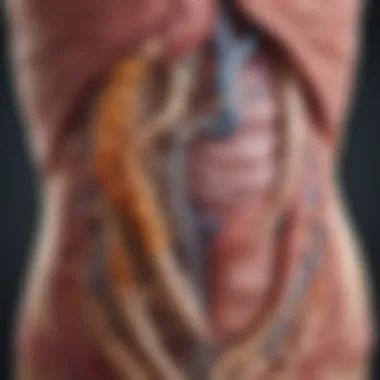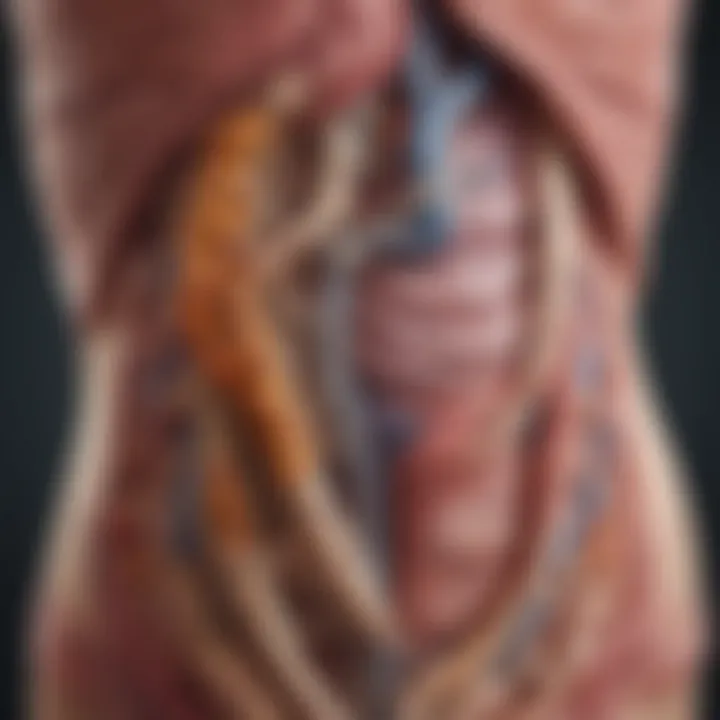Graft vs Host Disease of the Gut: An In-Depth Exploration


Intro
Graft vs Host Disease (GVHD) remains a central concern in the field of transplantation, particularly regarding its impact on the gastrointestinal tract. Understanding its dynamics is crucial for anyone involved in medical research, patient care, or education. GVHD is a condition that arises when donor immune cells attack the recipient's tissues, leading to significant morbidity. The gut is uniquely affected due to its complex immune environment and diverse microbiome. This phenomenon raises several questions about the underlying mechanisms of this disease and the strategies for its management.
In this exploration, we aim to provide clarity about GVHD and its specific implications for gut health. The interplay between immune responses and the gut microbiome is of particular interest. By synthesizing the latest research and clinical findings, our goal is to offer valuable insights that could enhance both understanding and treatment approaches for those affected by this condition.
As we delve deeper, we will touch upon various elements of GVHD, including the symptoms, diagnostic criteria, and emerging therapies. Keeping this multifaceted approach in mind will ensure a comprehensive grasp of the subject and its relevance in clinical settings.
Prelude to Graft vs Host Disease
Graft vs Host Disease (GVHD) is a complex and significant condition that typically occurs after a hematopoietic stem cell transplant. This phenomenon arises when the donor's immune cells recognize the recipient's tissues as foreign and initiate an immune response against them. The gastrointestinal tract is particularly vulnerable and heavily impacted by this condition. Understanding GVHD in this context is crucial for several reasons.
First, the gut plays a vital role in nutrient absorption, immune response, and overall health. When GVHD manifests in the gastrointestinal tract, it can lead to severe symptoms and complications, significantly affecting a patient’s quality of life. Moreover, the condition can be life-threatening if not adequately addressed. Understanding the specific dynamics of gut GVHD is essential for healthcare providers working with transplant recipients.
Second, the importance of gut health is increasingly recognized in various medical fields. The interplay between gut microbiota and immune responses is intricate and can influence the onset and severity of GVHD. This adds a layer of complexity, as interventions aimed at promoting gut health may potentially mitigate some effects of GVHD in the gut.
Finally, research advances suggest that awareness of GVHD and its management strategies can significantly enhance patient outcomes. By equipping healthcare professionals with deep insights into GVHD mechanisms, symptoms, and innovative treatment options, we can strive towards improved management protocols that address this formidable challenge.
Understanding GVHD
Graft vs Host Disease can be categorized into two main types: acute and chronic. Acute GVHD typically presents within days to weeks post-transplant, while chronic GVHD may develop months later. Both types can affect the gastrointestinal tract, manifesting in symptoms such as diarrhea, nausea, and stomach pain.
The underlying immune response in GVHD involves complex interactions between donor T-cells and the recipient's tissues. The recognition of host antigens by these T-cells triggers an inflammatory cascade that leads to tissue damage, particularly in the gut. This immune reaction is not only limited to the digestive system but can also affect skin, liver, and other organs, making comprehensive understanding essential for effective intervention.
Incidence and Prevalence
GVHD occurs with varying incidence rates depending on numerous factors, including the type of transplant, the source of donor cells, and the specificity of the donor and recipient's tissue compatibility. It is noted that acute GVHD affects approximately 30-50% of allogeneic transplant recipients, highlighting its commonality in post-transplant care. Chronic GVHD usually follows within the first few years after transplant and can occur in up to 50% of those who survive the acute phase.
It is significant to recognize how the likelihood of developing GVHD can be influenced by pre-transplant conditioning regimens. Research shows that intensity of chemotherapy or radiation therapy prior to transplant can elevate the risk of developing GVHD. Additionally, mismatched donor-recipient pairs are also at a higher risk.
This underscores the critical need for thorough screening and personalized approaches in transplant procedures. Identifying at-risk populations early can lead to tailored strategies that may reduce the incidence and adverse impacts of gut GVHD.
Pathophysiology of Gut GVHD
Understanding the pathophysiology of Gut Graft vs Host Disease (GVHD) is essential for grasping how these immune mechanisms function post-transplant. This section delves into the complex interactions that occur within the gastrointestinal tract, providing insights into why GVHD poses significant risks to patients. The pathophysiology directly influences the clinical manifestations seen in patients, guiding diagnostic and management strategies.
Immune Response Mechanisms
Role of T-Cells
In GVHD, T-cells play a pivotal role in the immune response against recipient tissues. After transplantation, donor T-cells recognize the host’s cells as foreign, triggering an immune attack. This specific activation of T-cells is a primary characteristic of GVHD. T-cells can differentiate into various subtypes that further propagate the inflammatory processes in the gut. The unique feature of T-cells in this context is their ability to evoke a strong immune response. However, this strength can also lead to severe damage to the gut epithelium and disrupt overall gut function, posing major challenges in treatment.
Cytokines Involvement
Cytokines are significant mediators in the immune system response, especially in GVHD. They facilitate communication between cells and can amplify inflammatory processes. The overproduction of certain cytokines can lead to exacerbated symptoms and complications. This particular aspect highlights the importance of cytokines in GVHD pathophysiology. A key characteristic of cytokines is that they can serve both as indicators of disease severity and as targets for therapeutic interventions. However, the challenge lies in balancing their effects. Understanding cytokines can assist in developing novel treatment approaches.
Impact on Gut Epithelium
Disruption of Barrier Function
GVHD leads to a significant disruption of the gut barrier function. This barrier is essential for preventing harmful substances from entering the bloodstream. The loss of this function can result in increased intestinal permeability, known as leakage, which can trigger systemic inflammatory responses. The characteristic feature of altered barrier function is its role in allowing pathogens and toxins to enter, causing additional complications. As such, addressing barrier disruption is crucial for managing GVHD effectively.
Inflammatory Response
The inflammatory response in GVHD is another critical element. Once T-cells and cytokines initiate inflammation, there is escalating damage to the gut lining. This inflammatory cascade can lead to serious complications such as ulcers and infections. A notable characteristic of this inflammatory response is its potential to become self-perpetuating. Understanding the inflammatory dynamics allows clinicians to consider multiple angles for treatment. Despite the necessity of inflammation in combating pathogens, excessive inflammation is harmful and can worsen GVHD symptoms.


It is vital to comprehend the pathophysiology of gut GVHD as it lays the foundation for effective diagnosis and management strategies, which directly impact patient outcomes.
Clinical Manifestations of Gut GVHD
Understanding clinical manifestations of Gut GVHD is vital for recognizing the disease and facilitating timely intervention. The gastrointestinal tract is often significantly affected by GVHD, leading to a variety of symptoms that can greatly impact quality of life. Early identification of these symptoms is crucial for effective management, which can prevent more severe complications. Commonly, both gastrointestinal and extraintestinal symptoms present together, making it essential for healthcare providers to comprehensively assess patients.
Gastrointestinal Symptoms
Diarrhea
Diarrhea is one of the most prevalent symptoms in patients with gut GVHD. It is often characterized by frequent, watery stools that can lead to dehydration and electrolyte imbalances. This symptom reflects the significant disruption in gut mucosal integrity caused by the immune response. In GVHD, the dysregulation of immune mechanisms leads to the inflammation of the intestinal lining. The key aspect of diarrhea is its potential severity, which can vary from mild to life-threatening. Treating diarrhea in GVHD patients not only helps alleviate discomfort but also protects against serious fluid loss, making it a focal point of management in this article. The unique feature of diarrhea in this context is its role as a marker for disease severity, where more significant diarrheal episodes often indicate more severe mucosal involvement.
Nausea and Vomiting
Nausea and vomiting are also common gastrointestinal symptoms in GVHD, stemming from the irritation of the gastrointestinal tract caused by immune-mediated injury. Nausea may result not only in discomfort but also in a decreased appetite, which can exacerbate the patient’s overall condition. The high incidence of these symptoms is a concern, as they can lead to malnutrition and further complications. The unique challenge here is that the management of nausea and vomiting requires careful evaluation of underlying causes which can be multifactorial. Such symptoms deserve attention in discussions around GVHD, as they highlight the complex interplay between gut health and overall patient wellness.
Abdominal Pain
Abdominal pain in Gut GVHD can be debilitating. Often described as cramping or sharp, the pain can be associated with increased discomfort after eating. This symptom results from how GVHD affects gut motility and inflammation. Understanding the origin of abdominal pain in these cases is crucial. It can assist in distinguishing between symptoms of GVHD and potential complications, like infections or blockages. Moreover, inadequate management of abdominal pain can significantly affect a patient's quality of life. Notable is that this symptom varies greatly among individuals, making it important to tailor management strategies to patient needs, which is a crucial aspect of this article.
Extraintestinal Manifestations
Skin Involvement
Skin involvement in GVHD serves as both a marker and complication of the disease. Often presenting as a rash, it can vary from mild to extensive lesions. Skin symptoms can lead to discomfort and psychosocial issues for patients. Highlighting this aspect emphasizes the systemic nature of the disease. Importantly, the management of skin symptoms in GVHD patients is essential as it reflects the level of inflammation within the body. Proactive skin care and treatment are crucial components of overall care strategies.
Liver Dysfunction
Liver dysfunction can manifest through elevated liver enzymes and jaundice. This aspect of GVHD is particularly concerning because it suggests systemic involvement of the disease. The liver plays a critical role in metabolism and detoxification. The unique feature of liver dysfunction in GVHD is that it often requires a collaborative approach to care, involving hepatologists and oncologists to address multifaceted issues. Liver health is integral to the patient’s overall prognosis in post-transplant situations.
Pulmonary Issues
Pulmonary manifestations in GVHD are less common, yet significant. Patients may experience cough, dyspnea, or even pneumonia due to compromised immune function. The unique characteristic of pulmonary issues is their potential to complicate management, as respiratory problems may be related to infections or other differential diagnoses. Understanding pulmonary involvement in GVHD is crucial for comprehensive patient care, as respiratory symptoms can severely impact recovery and quality of life.
"Timely recognition of symptoms in gut GVHD can lead to better management outcomes and significantly improve patient quality of life."
Diagnosis of GVHD Involving the Gut
The diagnosis of Graft vs Host Disease (GVHD) affecting the gastrointestinal tract is crucial for appropriate management and treatment. Early and accurate diagnosis can significantly influence patient outcomes. Diagnosis involves a combination of clinical assessment, diagnostic tests, and scoring systems. Each of these elements plays a distinct role in recognizing the presence and severity of the disease, guiding the treatment course that follows.
Clinical Assessment
Clinical assessment is often the first step in diagnosing gut GVHD. Healthcare providers rely on detailed patient histories and symptom evaluations. Symptoms such as diarrhea, abdominal pain, or nausea may suggest GVHD. A thorough examination may reveal extraintestinal symptoms, including skin rash or liver issues. This initial assessment helps in determining whether further diagnostic testing is warranted.
The importance of clinical assessment lies in its ability to provide immediate insights into the patient's condition. It also helps distinguish GVHD from other potential causes of gastrointestinal symptoms.
Diagnostic Tests
Endoscopy
Endoscopy plays a vital role in diagnosing gut GVHD. This procedure allows direct visualization of the gastrointestinal tract. It provides detailed information about the mucosal surface, its condition, and any visible lesions or inflammation. A key characteristic of endoscopy is its ability to take biopsy samples from targeted areas, which is necessary for a definitive diagnosis.
A unique feature of endoscopy is its minimally invasive nature, which makes it a popular choice in the clinical setting. However, while endoscopy is beneficial for assessing mucosal damage, it may not always capture all aspects of GVHD, particularly in cases with more diffuse disease activity.
Tissue Biopsy


Tissue biopsy remains essential for confirming the diagnosis of gut GVHD. The biopsy samples taken during endoscopy provide histological evidence of GVHD. This test's key characteristic is its ability to identify cellular changes typical of the disease, differentiating it from other gastrointestinal disorders.
A unique aspect of tissue biopsy is its role in understanding the extent and type of immune response present. While biopsy offers detailed insights, it can also be associated with discomfort and carries a small risk of complications.
Imaging Studies
Imaging studies provide further insights into the gastrointestinal condition. Techniques such as CT scans or MRI can reveal structural abnormalities in the gut. These studies are authorized for understanding the extent of inflammation or complications associated with GVHD. A key characteristic of imaging studies is their non-invasive nature, which can be more comfortable for patients compared to other diagnostic techniques.
However, while imaging can provide supportive information, it may not specify the type of changes occurring at a cellular level, necessitating further examination through endoscopy or biopsy.
Scoring Systems
International Bone Marrow Transplant Registry Criteria
The International Bone Marrow Transplant Registry Criteria offers a standardized method for assessing GVHD severity. This system is useful for comparing data across different studies and clinical settings. Its key characteristic is its ability to incorporate clinical data and laboratory findings into a coherent framework for diagnosis.
This scoring system aids healthcare providers in deciding treatment plans and outcomes, making it a beneficial tool in clinical practice. However, its complexity may pose challenges in real-time clinical decision-making.
Other Scoring Systems
Several other scoring systems have emerged, contributing to the assessment of GVHD. These systems may vary in parameters and methods but often focus on clinical and histological criteria. Their playful aspect is that they can be tailored specific to certain populations or clinical settings, which improves their relevance.
Despite their utility, the reliability of these scoring systems can be hindered by subjective interpretations of symptoms or biopsy results. Therefore, clinicians must consider these drawbacks when employing them in practice.
Management Strategies for Gut GVHD
Understanding management strategies for Gut GVHD is essential for improving patient outcomes. This condition can severely affect quality of life and may lead to significant complications if not properly addressed. A systematic and tailored approach to treating this disease is critical. It involves first-line therapies, alternative second-line options, and novel treatments. Each choice impacts recovery and patient well-being.
First-Line Treatments
Corticosteroids
Corticosteroids are often the first-line treatment for patients experiencing GVHD in the gut. This therapy works primarily by dampening the immune response, which is crucial because the immune system's attack on the gut is the primary issue in this disease. The key characteristic of corticosteroids is their potency in reducing inflammation quickly. They are a popular option due to their ability to provide fast relief from symptoms such as diarrhea and abdominal pain.
However, corticosteroids have unique features that warrant careful consideration. While they are effective, extended use can lead to various side effects, including weight gain, osteoporosis, and increased risk of infections. Balancing efficacy with these potential disadvantages is a constant challenge for healthcare providers treating GVHD.
Other Immunosuppressants
In addition to corticosteroids, other immunosuppressants are utilized as first-line treatments. Agents like tacrolimus and mycophenolate mofetil are often chosen for their ability to modulate immune responses beyond what corticosteroids can achieve alone. Their key characteristic lies in the more targeted immunosuppression they provide, allowing for potentially better management of GVHD without relying solely on steroids.
These alternatives ensure a more customized treatment approach. Yet, one must be aware of their unique features as well. Immunosuppressants can lead to serious complications, including infections and organ dysfunction. Hence, their use is carefully monitored in clinical settings to mitigate risks while effectively managing GVHD symptoms.
Second-Line and Novel Therapies
Monoclonal Antibodies
Monoclonal antibodies represent a significant advancement in the management of Gut GVHD. These therapies specifically target immune components responsible for the disease, providing a more focused approach than traditional treatments. Their notable characteristic is their ability to distinguish between healthy and harmful immune responses, which can lead to effective symptom relief.
The main reason monoclonal antibodies are seen as beneficial is their increased specificity, which can result in fewer side effects compared to broader immunosuppressants. However, this class of drugs may still have disadvantages, such as high costs and limited accessibility in some regions.
Small Molecule Inhibitors
Small molecule inhibitors are another promising area of study in GVHD management. These medications modulate cell signaling pathways critical in GVHD's development, offering a distinct mechanism of action. Their key characteristic is their potential for oral administration, making them more patient-friendly compared to intravenous options.
Such therapies show great promise due to their targeted action. However, the disadvantages can include varying efficacy among patients and potential side effects that still need to be fully understood. Research into their impact continues as the field looks for more refined options for GVHD management.


The management of Gut GVHD requires continuous evaluation of treatment responses and adjustments based on individual patient needs. Finding the right balance among therapies is key to improving outcomes.
Role of Gut Microbiome in GVHD
The gut microbiome plays a significant role in the development and progression of Graft vs Host Disease (GVHD). This community of microorganisms, including bacteria, archaea, viruses, and fungi, influences immune responses. Understanding the gut microbiome's dynamics is essential in managing GVHD effectively. It is especially relevant for those who undergo hematopoietic stem cell transplantation. Disruptions in microbial balance may worsen GVHD symptoms and complicate recovery.
Microbial Diversity and GVHD
Microbial diversity refers to the variety of microbial species present in the gut. A rich and diverse microbiome is generally associated with better health, including a robust immune response. Research indicates that reduced microbial diversity may correlate with a higher incidence of gut GVHD. When the gut microbiome lacks diversity, it can fail to provide necessary immune training, leading to an exaggerated immune response against the host tissues.
Moreover, specific microbial species have been identified as having protective roles in gut health. For example, certain strains of Lactobacillus and Bifidobacterium are known to enhance the barrier function of the gut epithelium. These bacteria can produce antimicrobial peptides and short-chain fatty acids, which help in maintaining gut integrity. Loss of such beneficial microorganisms can promote inflammatory processes, exacerbating GVHD.
Probiotic and Prebiotic Considerations
Probiotics and prebiotics are two critical elements that can influence gut health in the context of GVHD. Probiotics are live microorganisms that provide health benefits when consumed. They can help restore balance to the gut microbiome post-transplant. Some studies suggest that administering probiotics may alleviate gastrointestinal symptoms associated with GVHD. However, research in this area is still evolving, and caution is needed since particular strains may provoke immune reactions in susceptible patients.
Prebiotics, non-digestible food components, also play a vital role. They stimulate the growth and activity of beneficial bacteria already present in the gut. Adding prebiotic-rich foods like garlic, onions, and bananas may support a healthier microbiome. This support can be vital in managing GVHD, although more studies are required to establish specific dietary recommendations.
In summary, both probiotics and prebiotics hold potential for improving gut health and managing GVHD. Effective use of these interventions could enhance patient outcomes and quality of life post-transplant.
Current Research and Future Directions
Graft vs Host Disease (GVHD) remains a critical area of study, particularly regarding its impact on the gastrointestinal tract. Research contributes to deeper understanding and development of new strategies for management. Ongoing studies aim to uncover the complexities of immune responses and establish effective treatments. The focus on gut GVHD is vital due to its high incidence and potential for severe adverse outcomes.
Clinical Trials and Innovations
Clinical trials serve as a cornerstone for advancing our knowledge and therapeutic options for GVHD. These studies evaluate new medications, treatment protocols, and combinations of therapies. Participants benefit from cutting-edge approaches that might not be widely available. For instance, trials examining monoclonal antibodies and cellular therapies are showing promise in modifying immune responses without broadly suppressing the immune system. Such innovations are essential for improving patient outcomes.
Moreover, trials that investigate the gut microbiome's role in GVHD are gaining attention. There is an increasing recognition that gut flora significantly influences immune system functioning. Consequently, certain trials are assessing the use of probiotics and prebiotics as adjunct therapy, aiming to restore microbial balance and mitigate GVHD severity.
Potential Advances in Therapies
Looking ahead, the landscape of GVHD management may evolve substantially. New therapies focusing on targeted immune Modulation show great potential. For instance, small molecule inhibitors that disrupt pathways involved in T-cell activation are being investigated. These pharmaceutical advancements can potentially reduce the incidence and severity of GVHD while sparing other aspects of immune function.
Additionally, researchers emphasize the importance of personalized medicine. By analyzing individual genetic factors and response patterns, treatments can be tailored for optimal effect. This approach aims to mitigate GVHD through more precise and less invasive intervention strategies.
The future of GVHD treatment relies heavily on research innovations that address fundamental biological mechanisms.
In summary, current research highlights both clinical trials and potential advances in therapies significantly affect the management of gut GVHD. Continued exploration in this field can lead to improved strategies, enhancing patient care and quality of life.
The End and Implications
Recognizing the importnace of understanding Graft vs Host Disease (GVHD) of the gut is essential for advancing health care practices in transplant medicine. The implications of GVHD are profound, affecting not only patient well-being but also long-term treatment outcomes. Managing gut GVHD requires a multifaceted approach which includes early diagnosis and appropriate therapeutic strategies. This management can significantly reduce morbidity associated with the disease and improve quality of life for patients.
The interplay between immune mechanisms and gut health underscores the need for a holistic consideration of patient care. There is a crucial link between the immune response to transplants and the integrity of the gastrointestinal tract. Focusing on the gut microbiome's role offers promising directions for enhancing therapies and improving patient outcomes.
In summary, addressing the challenges posed by GVHD is vital for both clinicians and researchers. A deeper understanding can lead to better treatment protocols and, ultimately, improved recovery rates in patients undergoing transplant procedures.
Summary of Insights
This article has provided extensive insights into the complexities of GVHD of the gut. Key points discussed include:
- Pathophysiology: Delving into the immune mechanisms and how T-cells and cytokines contribute to gut damage.
- Clinical Manifestations: Recognizing the gastrointestinal symptoms associated with GVHD, such as diarrhea and abdominal pain, along with extraintestinal issues.
- Diagnostic Approaches: Evaluating clinical assessments and different diagnostic tests like endoscopy and tissue biopsy to confirm GVHD.
- Management Strategies: Discussing first-line treatments, such as corticosteroids, and exploring newer therapies like monoclonal antibodies.
- Future Considerations: Highlighting the influence of the gut microbiome on GVHD and its potential effects on therapeutic approaches.
These insights serve to accentuate the need for ongoing education, research, and a collaborative approach in tackling this complex condition.
Future Research Necessities
Future efforts should focus on several key areas to enhance the understanding and management of GVHD:
- Longitudinal Studies: Conducting long-term studies on the effects of various treatments on gut GVHD to ascertain their efficacy over time.
- Microbiome Research: Investigating the gut microbiome's role further could unveil novel strategies for intervention and support during the treatment of GVHD.
- Translational Research: Encouraging collaboration between basic scientists and clinical researchers to apply findings in real-world settings.
- Patient-Centered Approaches: Exploring how patient experiences and outcomes can inform treatment protocols. Engaging patients in research can lead to personalized medicine approaches, improving healthcare delivery.
In light of these necessities, it is clear that discussions around GVHD should continue evolving, driven by ongoing research and innovation in therapeutic modalities.







